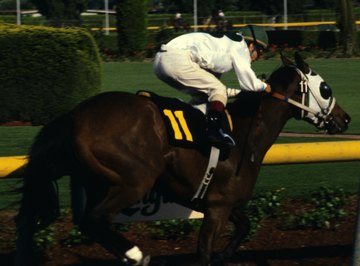
It may seem impossible that animals as different as Great Danes and Chihuahuas could both be members of the same species. Natural selection is the process by which organisms change over generations in response to environmental pressures, but humans also selectively breed plants and animals for traits that suit their needs in a process called artificial selection. Varieties of vegetables, such as broccoli, cabbage and kale, which all originated from wild mustard, are also examples of artificial selection.
Choosing Desirable Traits
Humans favor certain traits in the plants and animals they breed for various reasons, such as high sugar content in some fruits and vegetables, speed in race horses or high milk production in dairy animals. A desirable trait might represent one end of the spectrum of variation, such as animals that are larger or smaller than their species' average, or it might be a mutation that humans wish to perpetuate. An example of the latter is seedless fruit, an especially relevant example since the sterile fruit must rely on humans to help them reproduce.
Selective Breeding
Once a desirable trait has been identified, you then select those individuals that exhibit the trait and breed them together. Over successive generations of breeding, you only select those individuals that exhibit the trait you want. If the trait exists on a continuum, selective breeding means choosing those individuals that express the trait most strongly. Depending on the underlying genetic complexity and the degree to which a trait is heritable, or influenced by genetics, selective breeding over generations creates a population with the desired trait.
Removing Undesirable Individuals
The flip side of selective breeding is culling. Culling is removing individuals from the breeding population that do not have desirable traits. Depending on the type of plant or animal, culling can mean killing the individual or allowing it to live out its life, but not allowing it into the breeding population. Culling is probably the most controversial part of artificial selection in animals, since it can mean that otherwise healthy animals are killed.
Artificial Selection and Breeds
The objective of artificial selection is a population that reliably produces offspring with desired traits, called a breed or varietal. Sometimes selective breeding leads to an organism so different from its wild ancestor that it becomes a whole new species. Once you have a breed or varietal, you may be able to cross-breed it with another breed to get the desirable traits of both, although cross-bred organisms are more variable. For example, you could breed a disease-resistant variety of pea with one that has high yields, which may yield offspring possessing both traits. You may also be able to cross-breed two species. Donkeys and horses produce mules, which are sterile -- they can't produce offspring -- but our modern corn is the result of breeding maize with another wild grass, teosinte.
Side-Effects of Selective Breeding
Selective breeding, especially when you are selecting very strongly for one trait or for an extreme trait, can come with some baggage. Selective breeding tends to take genetic variability out of the population. This means that there are fewer traits competing with your desirable trait, but it can also concentrate mutations that may be problematic for the individual, such as hip dysplasia in dogs. Artificial selection in a species often must balance the desirability of a wide suite of traits with the overall health and robustness of the population.
References
- Berkley: Artificial Selection
- Encyclopaedia Britannica: Selection (Biology)
- University of California Santa Cruz Center for World History: The Biology of the Banana
- Cornell Department of Animal Science: Who’s Your Daddy? – Selective Breeding in Goats
- Roller Pigeons: Culling And Selective Breeding In Birmingham Roller Pigeons
- Northwestern University: Definitions: Breed True
- PBS: Dogs That Changed the World: Selective Breeding Problems
About the Author
Based in Wenatchee, Wash., Andrea Becker specializes in biology, ecology and environmental sciences. She has written peer-reviewed articles in the "Journal of Wildlife Management," policy documents,and educational materials. She holds a Master of Science in wildlife management from Iowa State University. She was once charged by a grizzly bear while on the job.
Photo Credits
Photos.com/Photos.com/Getty Images
